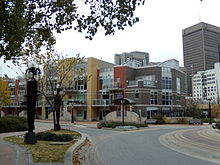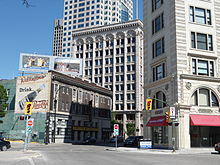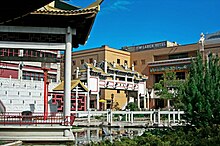Downtown Winnipeg
Downtown Winnipeg | |
|---|---|
 View of Downtown Winnipeg. | |
| Coordinates:49°53′44″N97°8′19″W/ 49.89556°N 97.13861°W | |
| Country | |
| Province | |
| City | Winnipeg |
| Area | |
| •Neighbourhood | 16.3 km2(6.3 sq mi) |
| • Metro | 5,306.79 km2(2,048.96 sq mi) |
| Population (2016) | |
| •Neighbourhood | 66,850[1] |
| • Density | 4,095.3/km2(10,607/sq mi) |
| •Metro | 778,489 |
| Time zone | UTC-6(Central Standard Time) |
| • Summer (DST) | UTC-5(Central Daylight Time) |
| Forward sortation areas | |
| Area code(s) | Area codes 204 and 431 |
Downtown Winnipegis an area ofWinnipeglocated near the confluence of theRedandAssiniboinerivers. It is the oldesturban areain Winnipeg, and is home to the city's commercial core, city hall, theseat of Manitoba's provincial government,and a number of major attractions and institutions.
The City of Winnipeg's official downtown boundaries are: theCanadian Pacific Railwaymainline on the north, Gomez Street and theRed Riveron the east, and theAssiniboine Riveron the south; the western boundaries of downtown are irregular, following along a number of different streets, back lanes, and across properties.[2]Generally speaking, the western boundaries are rarely much further west of Balmoral and Isabel Streets. In 2016,Canadian Geographicproduced a map that generalize Winnipeg's downtown boundaries.[3]
Neighbourhoods in the downtown area include theExchange District,Central Park,The Forks,andChinatown.The downtown area is roughly 3 square kilometres (740 acres).Winnipeg Square,Canada Life Centre,Portage Place,and the flagship store ofThe Bay(closed 30 November 2020) are all located on the downtown section ofPortage Avenue.OnMain StreetareWinnipeg's City Hall,Union Station,and theManitoba Centennial Centre,which includes theManitoba Museum,thePlanetarium,theCentennial Concert Hall,and theWinnipeg Railway Museum.Although over 60,000 people work downtown[citation needed],only 17,190 people live in the area covered by the Downtown Zoning By-Law.[4]
There are several residential projects under construction on Waterfront Drive and in the Exchange District, and the residential population of the area is projected to increase substantially in the next few years.
Neighbourhoods
[edit]TheDowntown Winnipeg Zoning By-Lawdefines the boundaries of the Downtown planning area, and several sectors within it. The downtowncensus areais slightly smaller, omitting a three-block extension at the north edge. There is also a significantly larger Downtown community area, used for Community Social Data Strategy for Winnipeg.[5][6]
Waterfront District
[edit]This section needs to beupdated.(June 2021) |
TheWaterfront Districtis a newly emergingmixed-use developmentlocated in the northeast corner of downtown Winnipeg. The district runs along the west bank of theRed Riveralong Waterfront Drive and featuresStephen Juba Park.[7]

The Waterfront District has seen a number ofresidential constructionprojects since 2005.[8]Moreover, there have been plans to extend Waterfront Drive further north, to connect it with theDisraeli Fwy.Developer Leon A. Brown has offered up to 12 properties forredevelopmentin the area.[9]Sunstone Boutique Hotels had an $11-million plan to build a three-storey, 67-roomboutique hotelon what is now agravelparking lot, along with a newcasual-dining restaurantin the one-storey brick former Harbourmaster's building. The plans also involve construction of a publicplazaarea at the south end of the property.[8][10]
The design of the Waterfront District also led to a new road system that included Winnipeg’s firstroundabout,at the corner of Bannatyne Avenue and Waterfront Drive.[7]
Central Park
[edit]Central Parkis one of Winnipeg's mostdensely-populatedneighbourhoods with 13,755 people per square km according to the2001 Census.Seventy per cent of all refugees coming to Winnipeg live downtown, in and around the Central Park area. Central Park includes many different ethnicities including Arabs, Vietnamese, Chinese, Ojibway, Filipinos, and African (more than half being African).
With the increase in the African population, Central Park has been transforming in recent years. It is now the home to the 'Central Market', with more markets planned to come. Many of the markets will sell handmade fashion and imported African crafts.
During warm Saturday nights, live entertainment fills the air, residents enjoy free Sunday movie screenings to enjoy an evening outdoors. The Knox Centre at Knox United Church presents international films in various languages - with English subtitles - every Thursday evening.
Exchange District
[edit]
TheExchange Districtis aNational Historic Site of Canada.Just one block north is one of Canada's most famous intersections,Portage and Main,the Exchange District comprises 20city blocksand approximately 150heritage buildings,[11]and it is known for its intactturn-of-the-centurycollection of warehouses, financial institutions, and earlyterracotta-clad skyscrapers.[12]
Winnipeg's theatre district is located on the east side of the Exchange District, home to theRoyal Manitoba Theatre Centre,andCentennial Concert Hallwhich houses theWinnipeg Symphony Orchestra,theRoyal Winnipeg Ballet,and theManitoba Opera.[13]The west side of the Exchange is home to Cinematheque, a small movie theatre located in the Artspace building on Albert Street.[14]
The Exchange District's Old Market Square annually hosts theJazz Winnipeg Festival,theWinnipeg Fringe Theatre Festival,and theManitoba Electronic Music Exhibition.Renovations to Old Market Square completed in 2012 added "The Cube", a $1.5 million stage, with a skin made up of 20,000 aluminum links.[15]The stage contains a built-in lighting system, green room and two performance levels.[15]
The district is home toRed River College's Roblin Centre[16]and thePaterson GlobalFoodsInstitute.[17]
Broadway-Assiniboine
[edit]
Broadway-Assiniboinelies in the southern part of downtown on the north bank of theAssiniboine River.The neighbourhood is one of the moredensely-populatedin Winnipeg, with 15,452.2 people per square kilometre.[18]It features many notable landmarks such as the historicUpper Fort Garry,Hotel Fort Garry,and theManitoba Legislative Building.Broadway-Assiniboine features the "Assiniboine Riverwalk" and is home to many notable restaurants.
The population of Broadway-Assiniboine was 5,270 as of the2016 Census.[18]The most common transportation method of the people in South Portage is walking, with 31.8%, more than 6.5 times higher than the overall 4.9% for Winnipeg.[18]The average employment income for the area is just $47,268, which is lower than Winnipeg's average employment income of $61,164.[18]
Current plans are for a new bicycle-pedestrian bridge to connect McFadyen Park with Fort Rouge Park over the Assiniboine River. The bridge would be partly financed by a grant from the Winnipeg Foundation. There are three designs vying for final approval.[19]
The Forks
[edit]
The Forksis a 99-acre (40 ha) national historic, recreational, cultural, and entertainment area site in downtown Winnipeg, deriving its name from being located where theAssiniboineandRed Riversmeet. The Forks was designated aNational Historic Siteof Canada in 1974 due to its status as acultural landscapethat had borne witness to six thousand years of human activity.[20]
South Portage
[edit]South Portageis the group ofcity blockslocated betweenPortage Avenue,Main Street,Broadway,and Memorial Boulevard.
The population of South Portage was 1,865 as of the2016 Census.[21]The most common transportation method of the people in South Portage is walking, with 42.4%, more than five times higher than the overall 4.9% for Winnipeg.[21]The average employment income for the area is just $52,267, which is lower than Winnipeg's average employment income of $61,164.[21]
South Portage is the location of the main branch of theWinnipeg Public Librarysystem, theMillennium Library.[22]
The area also has theWinnipeg Convention Centrewith 160,000 sq ft (15,000 m2) of meeting, exhibition and banquet space.[23]Lakeview Square,the largest mixed-use development downtown in the 1970s, was constructed at the same time as the Convention Centre and completed in 1974.
Opened in 2004, theBell MTS Placeis located just south of Portage Avenue and is home to theWinnipeg Jets.[24]
The area also has the Norquay Building, the Law Courts,Cityplace mall,andVJ's Drive Inn.There are numerous office buildings and hotels in this area, including some ofWinnipeg's tallest buildings.
A 42-storey apartment building,300 Main,is currently being built byArtis REIT,owners of 360 Main St. andWinnipeg Square.When completed, it will be the tallest apartment block in the city.
Winnipeg's public transit hub is located on theGraham Avenue Transit Mall,as many bus routes converge there.
Chinatown
[edit]
Formed in 1909,[25]the area is home to many shops and restaurants including Asian grocery stores and an herbal products store.[25]
Winnipeg'sChinatowncovers 0.1 square kilometres (0.039 sq mi) northwest of City Hall and is home to about 600 people, of whom 90% are in the Chinese visible minority group.[26]40.5% of the area's residents speak neither English nor French (as compared to 1% of Winnipeg as a whole), while 71.1% of residents speak some variant of Chinese (includingCantonese,Mandarinand Chinese not otherwise specified).[26]
River crossings
[edit]
Downtown Winnipeg has four bridges that directly connect to other Winnipeg neighbourhoods or suburbs across theRedandAssiniboine Rivers.They are the Main Street Bridge, Midtown Bridge, Osborne Street Bridge, and theProvencher Bridge.
One of the first bridges in Winnipeg was the Main-Norwood Bridge. It carries traffic betweenSt. Boniface,St. Vital,and points east from Marion Street. Originally a toll bridge, it carried Winnipeg's firsthorse-drawn streetcarsbetween downtown and River Avenue in the early 1880s.
Osborne Street Bridge connectsOsborne Villageto the downtown core. The first iteration was built in the late 1880s. In the 2010s the bridge was upgraded with a lit wall using LED technology.
The Midtown Bridge carries traffic to and from south Winnipeg. It was first opened in September 1955.[27]The Bridge sees upwards of 59,300 vehicles average weekdays.[28]
The Provencher Bridge is the third one built. The first version, called the Broadway Bridge, was not engineered correctly and fell into the Red River four days after opening due toice jamscolliding with it. The second version outlived its usefulness and was replaced in the 2000s. The new Provencher Bridge opened to vehicular traffic in December 2003.[29]Located adjacent to the Provencher Bridge is thecable-stayedpedestrian and cycling bridge,Esplanade Riel,opened in 2004. It features space for an indoor restaurant.
Other features
[edit]Sports venues
[edit]There are two major sports venues located downtown,Canada Life Centrewhere the NHL'sWinnipeg JetsandManitoba Moosehave played since 2004; andBlue Cross Park,where theAmerican Association'sWinnipeg Goldeyesbaseball team have played since 1999.
Winnipeg Walkway System
[edit]TheWinnipeg Walkwaysystem, popularly known as the Winnipeg Skywalk, is a network of pedestrianskywaysandtunnelsconnecting a significant portion of the city centre.[30]
Media
[edit]Several media organizations have broadcasting studio located in the downtown area, including television stationsCTV,Global,Citytv,and Canadianspecialty channelAPTN;and radio stationsQX-104,and 93.7 Nostalgia FM.
The television broadcast antennas forCBC ManitobaandICI Radio-CanadaManitoba are located on theRichardson Building,while Global TV Winnipeg is located on top of 201Portage Avenue.
Border Crossings,an internationally known arts magazine featuring Canadian art, publishes from offices in theExchange District.Where Winnipegmagazine features listings of things to do in Winnipeg and is also published from the Exchange District.
Education
[edit]Isbister School is anAdult Education Centreoperated by theWinnipeg School Divisionin the north Portage Avenue area.[31]Other private schools serve business needs, such asCDIandBooth University College.
See also
[edit]Notes
[edit]- ^abWinnipeg, Government of the City of."City of Winnipeg Community Area Profiles".winnipeg.ca.Archivedfrom the original on 10 June 2021.Retrieved12 March2020.
- ^"Map for OurWinnipeg Adopted by City Council".Archived fromthe originalon 3 April 2018.Retrieved2 April2018.
- ^Kylie, Aaron (27 September 2016)."Six maps that put Canada's downtown cores in context".Canadian Geographic.Archivedfrom the original on 3 April 2018.Retrieved2 April2018.
- ^"2021 Census Data - Downtown Zoning By-law".City of Winnipeg.City of Winnipeg. 2023.Archivedfrom the original on 17 February 2024.Retrieved8 July2024.
- ^"(UD): 2001 Census".Winnipeg.ca.Archivedfrom the original on 1 August 2010.Retrieved26 January2011.
- ^"2016 Census - City of Winnipeg Community Area Profiles".Winnipeg.ca.7 February 2019.Archivedfrom the original on 21 December 2019.Retrieved19 September2019.
- ^abhttps://www.umanitoba.ca/faculties/architecture/media/CiP_2009_Marli.pdfArchived6 November 2021 at theWayback Machine[bare URL PDF]
- ^abMcNeill, Murray (4 July 2011)."Waterfront set for leap forward".Winnipeg Free Press.Archivedfrom the original on 13 December 2012.Retrieved16 October2012.
- ^"Waterfront North".Leon A. Brown Ltd.Archivedfrom the original on 21 September 2019.Retrieved21 September2019.
- ^"Harbour Master Hotel Landscape Concept Plan".February 2011. Archived fromthe originalon 11 December 2013.Retrieved16 October2012.
- ^"Historic Exchange".Archivedfrom the original on 24 February 2013.Retrieved20 August2012.
- ^"The Exchange District A National Historic Site Heritage Interpretation Strategy"(PDF).The Exchange District Heritage Partnership. July 1999. p. 12. Archived fromthe original(PDF)on 4 March 2016.Retrieved21 September2012.
- ^"Theatres".The Exchange District. Archived fromthe originalon 24 February 2013.Retrieved21 September2012.
- ^"Cinematheque".Cinematheque. Archived fromthe originalon 21 September 2012.Retrieved21 September2012.
- ^ab"Old Market Square".Winnipeg Downtown Places. 19 June 2010.Archivedfrom the original on 5 December 2013.Retrieved20 August2012.
- ^"The Roblin Centre".Red River College. Archived fromthe originalon 2 November 2012.Retrieved21 September2012.
- ^Forlanski, Tamara (21 February 2013)."RRC opens high-end restaurant in Exchange".Global News Winnipeg.Archivedfrom the original on 10 April 2021.Retrieved19 September2019.
- ^abcd"2016 Census Data - Broadway-Assinboine"(PDF).Winnipeg.ca.24 July 2019.Archived(PDF)from the original on 11 April 2021.Retrieved18 September2019.
- ^Santin, Aldo; Turner, Randy (24 May 2018). "City unveils three options for pedestrian/bike bridge over Assiniboine".
- ^"The Forks National Historic Site of Canada".www.pc.gc.ca.Archivedfrom the original on 12 April 2021.Retrieved14 November2019.
- ^abc"2016 Census Data - South Portage"(PDF).Winnipeg.ca.24 July 2019.Archived(PDF)from the original on 11 April 2021.Retrieved18 September2019.
- ^"Winnipeg Millennium Library".LM Architectural Group. 17 October 2010.Archivedfrom the original on 5 November 2012.Retrieved16 October2012.
- ^"Winnipeg Convention Centre".Winnipeg Convention Centre. Archived fromthe originalon 29 October 2012.Retrieved16 October2012.
- ^"MTS Centre / True North Arena".MTS Centre. Archived fromthe originalon 17 June 2012.Retrieved16 October2012.
- ^ab"Chinatown | Tourism Winnipeg".Archived fromthe originalon 28 May 2012.Retrieved11 October2012.
- ^ab"2006 Census Data China Town"(PDF).2006 Census Data.City of Winnipeg.Archived(PDF)from the original on 21 November 2011.Retrieved11 October2012.
- ^"Bridge Opened: Another Needed".Winnipeg Free Press.15 September 1955. p. 1.
- ^"2018 Traffic Flow Map"(PDF).City of Winnipeg.4 June 2018.Archived(PDF)from the original on 20 September 2019.Retrieved20 September2019.
- ^"Esplanade Riel opens to public".Winnipeg.ca.30 December 2003.Archivedfrom the original on 20 September 2019.Retrieved20 September2019.
- ^"Indoor Walkways".Downtown Winnipeg Biz. Archived fromthe originalon 31 December 2008.Retrieved10 August2012.
- ^"Historic Sites of Manitoba: Isbister School".Manitoba Historical Society.11 May 2019.Retrieved19 September2019.

